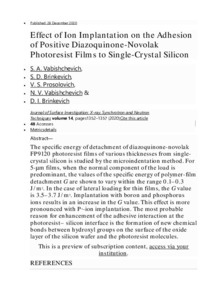Please use this identifier to cite or link to this item:
https://elib.psu.by/handle/123456789/28812| Title: | Effect of Ion Implantation on the Adhesion of Positive Diazoquinone-Novolak Photoresist Films to Single-Crystal Silicon |
| Authors: | Vabishchevich, S. Brinkevich, S. Prosolovich, V. Vabishchevich, N. Brinkevich, D. |
| Issue Date: | 2020 |
| Publisher: | Springer |
| Citation: | Vabishchevich, S.A., Brinkevich, S.D., Prosolovich, V.S. et al. Effect of Ion Implantation on the Adhesion of Positive Diazoquinone-Novolak Photoresist Films to Single-Crystal Silicon. J. Synch. Investig. 14, 1352–1357 (2020). https://doi.org/10.1134/S1027451020060476 |
| Abstract: | The specific energy of detachment of diazoquinone-novolak FP9120 photoresist films of various thicknesses from single-crystal silicon is studied by the microindentation method. For 5-μm films, when the normal component of the load is predominant, the values of the specific energy of polymer-film detachment G are shown to vary within the range 0.1–0.3 J/m2. In the case of lateral loading for thin films, the G value is 3.5–3.7 J/m2. Implantation with boron and phosphorus ions results in an increase in the G value. This effect is more pronounced with P+-ion implantation. The most probable reason for enhancement of the adhesive interaction at the photoresist– silicon interface is the formation of new chemical bonds between hydroxyl groups on the surface of the oxide layer of the silicon wafer and the photoresist molecules. |
| URI: | https://elib.psu.by/handle/123456789/28812 |
| metadata.dc.identifier.doi: | 10.1134/S1027451020060476 |
| Appears in Collections: | Публикации в Scopus и Web of Science |
Files in This Item:
| File | Description | Size | Format | |
|---|---|---|---|---|
| Vabishchevich.pdf | 139.61 kB | Adobe PDF |  View/Open |
Items in DSpace are protected by copyright, with all rights reserved, unless otherwise indicated.